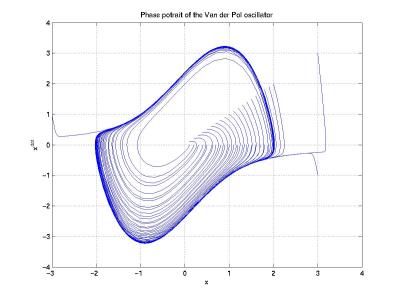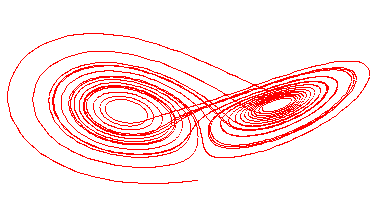Attractor
|
|
In dynamical systems, an attractor is a set to which the system evolves after a long enough time. For the set to be an attractor trajectories that get close enough to the attractor must remain close even if slightly disturbed. Geometrically, an attractor can be a point, a curve, a manifold, or even a complicated set with fractal structures known as a strange attractor. Describing the attractors of chaotic dynamical systems have been one of the achievements of chaos theory.
A trajectory of the dynamical system in the attractor does not have to satisfy any special constraints except for remaining on the attractor. The trajectory may be periodic or chaotic or of any other type.
| Contents |
Motivation and definition
Dynamical systems are often described in terms of differential equations. These equations describe the behavior of the system for a short period of time. To determine the behavior for longer periods it is necessary to integrate the equations, either through analytical means or through iteration, often with the aid of computers. Dynamical systems that come from applications tend to be dissipative: if it were not for some driving force the motion would cease. (The dissipation may come from internal friction, thermodynamic losses, or loss of material, among many causes.) The dissipation and the driving force tend to combine to kill out initial transients and settle the system into its typical behavior. The part of the phase space of the dynamical system corresponding to the typical behavior is the attracting set or attractor.
Invariant sets and limit sets are similar to the attractor concept. An invariant set is a set that evolves to itself under the dynamics. Attractors may contain invariant sets. A limit set are the states a system goes to after an infinite amount of time. Attractors are limit sets, but not all limit sets are attractors. It is possible to have a system converge to a limit set, but if placed in the limit set, have small perturbations that knock it off to never return.
As an example, the damped pendulum has two invariant points: the point x0 of minimum height and the point x1 of maximum height. The point x0 is also a limit set, as trajectories converge to it; the point x1 is not a limit set. Because of the dissipation, the point x0 is also an attractor. If there were no dissipation, x0 would not be an attractor.
Mathematical definition
In a dynamical system with dynamics f(t, •), the attractor Λ is a subset of the phase space such that:
- there is a neighborhood of Λ, the attraction basin, that will converge to any open containing Λ, and
- f(t, Λ) ⊃ Λ for large t.
The open subset condition assures that phase space points in the neighborhood of the attractor converge to it.
Types of attractors
Attractors are parts of the phase space of the dynamical system. Until the 1960s, as evidenced by textbooks of that era, attractors were thought of as being geometrical subsets of the phase space: points, lines, surfaces, volumes. The (topologically) wild sets that had been observed were thought to be fragile anomalies. Stephen Smale was able to show that his horseshoe map was robust and that its attractor had the structure of a Cantor set.
Two simple attractors are the fixed point and the limit cycle. There can be many other geometrical sets that are attractors. When these sets (or the motions on them), are hard to describe, then the attractor is a strange attractor, as described in the section below.
Fixed point
A fixed point is a point that a system evolves towards, such as the final states of a falling pebble, a damped pendulum, or the water in a glass. It corresponds to a fixed point of the evolution function that is also attracting.
Limit cycle
A limit cycle is a repeating sequence of states, a periodic orbit of the dynamics. Examples include the swings of a pendulum clock, the tuning circuit of a radio, and the heartbeat while resting. If the dynamical system is discrete in time, then the limit cycle could be a finite-length repeating loop of discrete states.
Strange attractor
An attractor is informally described as strange if it has non-integer dimension or if the dynamics on the attractor are chaotic. The term was coined by David Ruelle and Floris Takens to describe the attractor that resulted from a series of bifurcations of a system describing fluid flow. Strange attractors are often differentiable in a few directions and like a Cantor dust (and therefore not differentiable) in others.
The Hénon attractor and the Lorenz attractor are examples of strange attractors.
Partial differential equations
Parabolic partial differential equations may have finite-dimensional attractors. The diffusive part of the equation damps higher frequencies and in some cases leads to a global attractor. The Ginzburg-Landau, the Kuramoto-Sivashinsky, and the two-dimensional, forced Navier-Stokes equations are all known to have global attractors of finite dimension.
For the three-dimensional, incompressible Navier-Stokes equation with periodic boundary conditions, if it has a global attractor, then this attractor will be of finite dimension.
Further reading
- Edward N. Lorenz (1996) The Essence of Chaos ISBN 0295975148
- James Gleick (1988) Chaos: Making a New Science ISBN 0295975148
External links
- A gallery of polynomial strange attractors (http://ccrma-www.stanford.edu/~stilti/images/chaotic_attractors/poly.html)
- 3D Strange Attractor Gallery (http://hbar.servebeer.com/~val/attractors/index-1.html)


